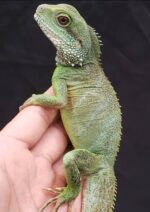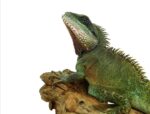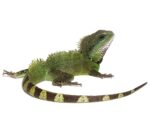Description
Physignathus cocincinus is a species of agamid lizard native to southern China and mainland Southeast Asia. It is commonly known as the Chinese water dragon for sale, Indochinese water dragon, Asian water dragon, Thai water dragon, or green water dragon.
Chinese water dragons are large diurnal lizards adapted for dense subtropical forests replete with unpolluted streams. They are semi-arboreal, roosting at night on branches overlooking streams, which offer an escape route when the lizards are disturbed. Arthropods are their main source of food, though worms, snails, vertebrates, and plants make up a notable portion of the diet as well.
Males are territorial towards each other and bear display features such as crests and jowls. Females are oviparous and reproduce sexually in the wild, though at least one captive Chinese water dragon is known to have reproduced via parthenogenesis.
Physignathus cocincinus is related to Australasian lizards in the subfamily Amphibolurinae. One amphibolurine, the Australian water dragon (Intellagama lesuerii) is so anatomically and ecologically similar to Physignathus cocincinus that it was once (erroneously) placed in the same genus.
Feral populations introduced to Hong Kong and Taiwan flourish in high densities despite countermeasures in the latter territory. Their populations are also stable (albeit not widespread) in protected areas of Thailand.
However, in the rest of their native range, Chinese water dragons have seen sharp population declines in recent decades. They are listed as a Vulnerable species at risk of extinction in the future, based on current trends. The largest threat to the species is overharvesting for meat and the pet trade.
Their meat is in high demand in Vietnam, and captive breeding is currently incapable of replacing wild collection by hunters and poachers. Due to their charismatic appearance, captured Chinese water dragons are sold as pets for both local and international markets.
Yearly exports to the European Union and the United States number in the tens of thousands, all of which are taken from wild populations. Habitat loss is another source of pressure, as undisturbed streamside forest is converted into cropland or subjected to illegal logging and other human activities.
Taxonomy of Chinese Water Dragon For Sale

The species and genus were first described by Georges Cuvier in 1829. Cuvier’s original spelling, ‘Phyhignat,us cocincinus‘, is likely a printing error. The epithet cocincinus is from the French term Cocincine, for the type locality Cochin-china (an exonym of Vietnam).
During the 19th and 20th centuries, several other species of agamid lizards were placed in Cuvier’s genus Physignathus. These have been reclassified into separate genera, leaving Chinese Water Dragon For Sale with only the original species P. cocincinus remaining. For example, the Australian water dragon (Intellagama lesueurii) was known as Chinese Water Dragon for sale for much of its history.
The Water Dragon can be identified by a distinctively deep angular head and nuchal crest of spinose scales that joins the vertebral crest extending down the length of its body to the tail. Enlarged spinose scales are also present across the lateral surface, unevenly distributed amongst regular keeled scales.
The jowls are large and ear is exposed and of almost equal size of the eye. The dorsal ridge and tail are laterally compressed and the limbs are strong and robust with particularly long toes on the hind legs. The tail is capable of regeneration when lost, furthermore, regenerated tails can also grow back when severed.
Colouration differs between the subspecies; the Eastern Water Dragon, Intellagama lesueurii lesueurii, has a grey to brownish-grey colour above with patterns of black stripes along the dorsal ridge as well as down the tail. There is also a dark stripe horizontally from the eye back over the tympanum and extending down the neck.
The limbs are mostly black with spots and stripes of grey and the tail is patterned with grey and black stripes. The ventral surface is yellowish-brown, with the chest and upper belly becoming bright red in mature males.
The Gippsland Water Dragon, Intellagama lesueurii howittii, is identical in morphology apart from slightly smaller spinose scales but differs in colouration and patterning.
Dorsally the body is olive-green to brown in colour with transverse black stripes. The dark stripe from the eye to ear is absent. Mature Chinese Water Dragon For Sale males have dark blue-green chests and streaks of yellow and blue around the neck and throat.












Reviews
There are no reviews yet.